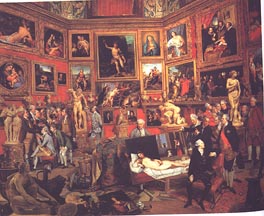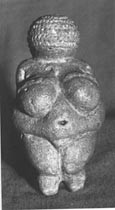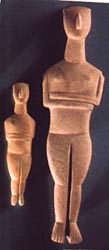
Art Home | ARTH Courses | ARTH 220
The Female Nude
Baldesar Castiglione, The Book of the Courtier, Book III, 15 (p. 217): "...I will say only that in the opinion of very wise men, as you know, man is as the form and the woman as the matter; and therefore, just as the form is more perfect than the matter-- nay, gives it its being-- so man is far more perfect than woman."
Johann Zoffany, born in Germany but active in England after the 1760's, painted a group of English gentlemen who as part of their grand tour of Europe visited the Uffizi collection in Florence. The painting, dated between 1772-1778, is set in the octagonal gallery known as the Tribuna, which was originally made by the Medici family. In the Zoffany painting, the room is packed with many of the major masterpieces in Florentine collections [see Web page dedicated to the Zoffany painting for the identification of these paintings]. Given special prominence are Titian's Venus of Urbino and the Medici Aphrodite. The singling out of these two works was clearly intentional. The juxtaposition of these two works clearly demonstrate the continuity of Western art with the Titian painting reviving the subject of the female nude from antiquity. The prominence of these two works also attest to the central position the subject matter of the female nude in Western art. As Linda Nead has written in her The Female Nude:
| More than any other subject, the female nude connotes 'Art'. The framed image of a female body, hung on the wall of an art gallery, is shorthand for art more generally; it is an icon of western culture, a symbol of civilization and accomplishment....[T]he female nude is not simply one subject among a whole range of subjects that artists have chosen to depict with the history of art; rather, it should be recognized as a particularly significant motif within western art and aesthetics. The representation of the female body within the forms and frames of high art is a metaphor for the value and significance of art generally. It symbolizes the transformation of the base matter of nature into the elevated forms of culture and the spirit. The female nude can thus be understood as a means of containing femininity and female sexuality. If...the female body had been regarded as unformed, undifferentiated matter, then the procedures and conventions of high art are one way of controlling this unruly body and placing it within the securing boundaries of aesthetic discourse.[p.1-2] |
Consider Nead's argument in relationship to the following passage from Kenneth Clark's still influential book entitled The Nude (1956):

|

|
|
|
| Plato, in his Symposium, makes one of the guests assert that there are two Aphrodites, whom he calls Celestial and Vulgar, or, to give them their later titles, Venus Coelestis and Venus Naturalis; and because it symbolized a deep-seated human feeling, this passing allusion was never forgotten. It became an axiom of medieval and Renaissance philosophy. It is the justification of the female nude. Since the earliest times the obsessive, unreasonable nature of physical desire has sought relief in images, and to give these images a form by which Venus may cease to be vulgar and become celestial has been one of the recurring aims of European art. The means employed have been symmetry, measurement, and the principle of subordination, all refining upon the personal affections of individual artists. But perhaps this purification of Venus could not have taken place had not some abstract notion of the female body been present in the Mediterranean mind from the first. Prehistoric images of women are of two kinds, the bulging statuettes from paleolithic caves (figure 2), which emphasize the female attributes till they are little more than symbols of fertility, and the marble dolls of the Cyclades (figure 3), in which already the unruly human body has undergone a geometrical discipline [p. 109]. |
Contrast Kenneth Clark's statement with its concerns with controlling the "unreasonable nature of physical desire" to the more recent definition by T.J. Clark: "A nude...is a picture for men to look at, in which Woman is constructed as an object of somebody else's desire." Or consider the following statement by Parker and Pollock in their Old Mistresses: "The images reproduce on the ideological level of art the relations of power between men and women. Woman is present as an image but with specific connotations of body and nature, that is passive, available, possessable, powerless. Man is absent from the image but it his speech, his view, his position of dominance which the images signify."
In looking at the Zoffany painting and considering this chain of quotations, consider how we are intended to look at these images of the nude. As Nead in her book argues: " The female nude is the border ... between art and obscenity. The female body --natural, unstructured-- represents something that is outside the proper field of art and aesthetic judgement; but artistic style, pictorial form, contains regulates the body and renders it an object of beauty, suitable for art and aesthetic judgement[p.25]." What is the boundary between the gentlemen admiring the beautiful form of the Medici Aphrodite in the Zoffany painting and a group of men gawking at a pole dancer? A 2006 show of the photographs of Tom Hunter at the National Gallery in London raises just these issues.
Or consider the following photograph of apparently two art historians discussing a work of the Venetian artist Tintoretto that accompanied a New York Times review of a Tintoretto show held at the Prado Museum in Madrid during the Spring of 2007:
The painting they are discussion is Tintoretto's Susanna and the Elders:
Some editor at The Times had a good sense of humor.
See also the article in The Guardian entitled Nude Awakening by Frances Borzello.
We will focus our discussion on the female nude on the following five examples, taken from dramatically different periods of art. In considering these pay attention to the different conceptions of the female body. In your journal write down your responses to this. To give you background, review the Web pages linked to the particular images.
Praxiteles, Aphrodite of Knidos, Roman copy of an original of c. 350-340 BCE |
|
Titian, Venus of Urbino, 1538. |
Manet, Olympia,1863. |
Jenny Saville, The Plan, 1993, oil on canvas, 9' X 7' |
|